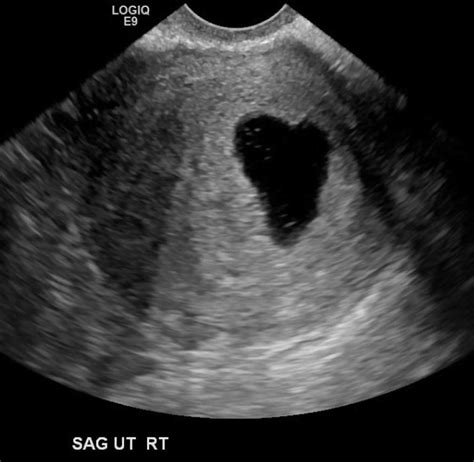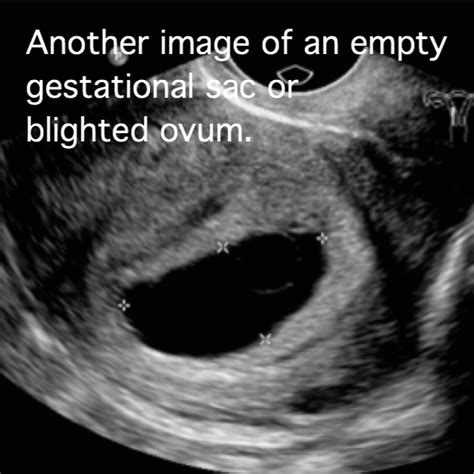Intro
A blighted ovum, also known as an anembryonic pregnancy, is a type of failed pregnancy where a fertilized egg implants in the uterus but fails to develop into a viable embryo. This condition occurs when a fertilized egg undergoes abnormal cell division, resulting in the formation of a gestational sac, but no embryonic tissue develops. As a result, the pregnancy is not viable, and the body will eventually recognize this and miscarry.
The term "blighted ovum" can be misleading, as it implies that the ovum (egg) itself is defective. However, this is not always the case. In many instances, the issue lies with the sperm or the fertilization process, rather than the egg. A blighted ovum can occur in any pregnancy, and it is estimated that up to 50% of early miscarriages are due to this condition. Despite its frequency, a blighted ovum can be a devastating experience for women and couples trying to conceive.
The symptoms of a blighted ovum can vary, but they often resemble those of a normal pregnancy, including a missed period, morning sickness, and breast tenderness. However, as the pregnancy progresses, the body may begin to recognize that something is amiss, and the woman may experience vaginal bleeding, cramping, or a decrease in pregnancy symptoms. In some cases, a blighted ovum may be asymptomatic, and the woman may only discover the issue during a routine ultrasound.
Causes Of A Blighted Ovum

Genetic abnormalities are a common cause of blighted ovum, accounting for up to 50% of cases. These abnormalities can occur in either the egg or sperm and can affect the development of the embryo. Hormonal imbalances, particularly those related to progesterone and estrogen, can also disrupt the normal development of the embryo. Issues with the fertilization process, such as poor sperm quality or ovulation problems, can also increase the risk of a blighted ovum.
Genetic Abnormalities
Genetic abnormalities can occur in either the egg or sperm and can affect the development of the embryo. These abnormalities can be inherited or occur spontaneously, and they can affect the number or structure of the chromosomes. In some cases, genetic abnormalities may be related to underlying medical conditions, such as Turner syndrome or Klinefelter syndrome.Hormonal Imbalances
Hormonal imbalances, particularly those related to progesterone and estrogen, can disrupt the normal development of the embryo. Progesterone is essential for maintaining the pregnancy, and low levels of this hormone can increase the risk of miscarriage. Estrogen, on the other hand, plays a crucial role in the development of the embryo, and imbalances in this hormone can affect the growth and development of the fetus.Diagnosis Of A Blighted Ovum

The diagnosis of a blighted ovum can be confirmed through a combination of ultrasound and blood tests. The ultrasound will show the presence of a gestational sac, but no embryonic tissue. Blood tests will reveal low levels of human chorionic gonadotropin (hCG), a hormone produced by the placenta during pregnancy. In some cases, a blighted ovum may be diagnosed during a dilation and curettage (D&C) procedure, which involves removing tissue from the uterus.
Ultrasound Diagnosis
Ultrasound is the primary method of diagnosing a blighted ovum. During the ultrasound, the doctor will look for the presence of a gestational sac and embryonic tissue. If the gestational sac is larger than expected, but there is no embryonic tissue present, a blighted ovum may be suspected. The doctor may also use transvaginal ultrasound to get a closer look at the uterus and gestational sac.Blood Tests
Blood tests can confirm the diagnosis of a blighted ovum by measuring the levels of hCG in the blood. Low levels of hCG can indicate a non-viable pregnancy, such as a blighted ovum. The doctor may also use blood tests to rule out other conditions, such as an ectopic pregnancy or a molar pregnancy.Treatment Options For A Blighted Ovum

A D&C procedure involves dilating the cervix and removing the tissue from the uterus using a suction device. This procedure can help to reduce the risk of infection and promote healing. In some cases, the doctor may also prescribe medication to help the uterus contract and expel the tissue.
Natural Miscarriage
In many cases, the body will miscarry the pregnancy naturally, and no treatment is necessary. This can occur within a few days to a few weeks after the diagnosis. During this time, the woman may experience vaginal bleeding, cramping, and other symptoms of miscarriage.D&C Procedure
A D&C procedure is a surgical procedure that involves removing the tissue from the uterus. This procedure can help to reduce the risk of infection and promote healing. The procedure is usually performed under general anesthesia, and the woman can return home the same day.Prevention Of A Blighted Ovum

Maintaining a healthy weight can help to reduce the risk of miscarriage, including a blighted ovum. Women who are overweight or underweight are at a higher risk of miscarriage, and maintaining a healthy weight can help to reduce this risk. Avoiding smoking and alcohol can also help to reduce the risk of miscarriage, as these substances can affect the development of the embryo.
Healthy Lifestyle
Maintaining a healthy lifestyle can help to reduce the risk of a blighted ovum. This includes eating a balanced diet, getting regular exercise, and managing stress. A healthy lifestyle can help to promote overall health and well-being, reducing the risk of miscarriage and other pregnancy complications.Managing Underlying Medical Conditions
Managing underlying medical conditions, such as PCOS or thyroid disorders, can help to reduce the risk of a blighted ovum. Women with these conditions should work closely with their healthcare provider to manage their condition and reduce their risk of miscarriage.Emotional Support After A Blighted Ovum

It is essential to remember that a blighted ovum is not a reflection of a woman's worth or fertility. It is a common condition that can occur in any pregnancy, and it is not a guarantee that future pregnancies will be affected. Women and couples should seek support and guidance from their healthcare provider, and they should not hesitate to reach out for emotional support during this challenging time.
Counseling
Counseling can provide a safe and supportive environment for women and couples to process their emotions and work through their grief. A therapist can help individuals to develop coping strategies and provide guidance on how to navigate the emotional challenges of a blighted ovum.Support Groups
Support groups can provide a sense of community and connection for women and couples who have experienced a blighted ovum. These groups can offer a safe space to share experiences, ask questions, and receive support from others who have gone through a similar experience.What is a blighted ovum?
+A blighted ovum, also known as an anembryonic pregnancy, is a type of failed pregnancy where a fertilized egg implants in the uterus but fails to develop into a viable embryo.
What are the symptoms of a blighted ovum?
+The symptoms of a blighted ovum can vary, but they often resemble those of a normal pregnancy, including a missed period, morning sickness, and breast tenderness.
How is a blighted ovum diagnosed?
+A blighted ovum is typically diagnosed during a routine ultrasound, usually between 6-10 weeks of gestation.
What are the treatment options for a blighted ovum?
+The treatment options for a blighted ovum depend on the individual circumstances and the stage of pregnancy. In most cases, the body will miscarry the pregnancy naturally, and no treatment is necessary.
Can a blighted ovum be prevented?
+While it is not possible to completely prevent a blighted ovum, there are several steps that women can take to reduce their risk, including maintaining a healthy weight, avoiding smoking and alcohol, and managing underlying medical conditions.
We hope this article has provided you with a comprehensive understanding of a blighted ovum, including its causes, symptoms, diagnosis, treatment options, and prevention. If you have any further questions or concerns, please do not hesitate to reach out to your healthcare provider. Remember, a blighted ovum is a common condition that can occur in any pregnancy, and it is not a reflection of a woman's worth or fertility. With the right support and guidance, women and couples can navigate the emotional challenges of a blighted ovum and move forward with their reproductive journey.
